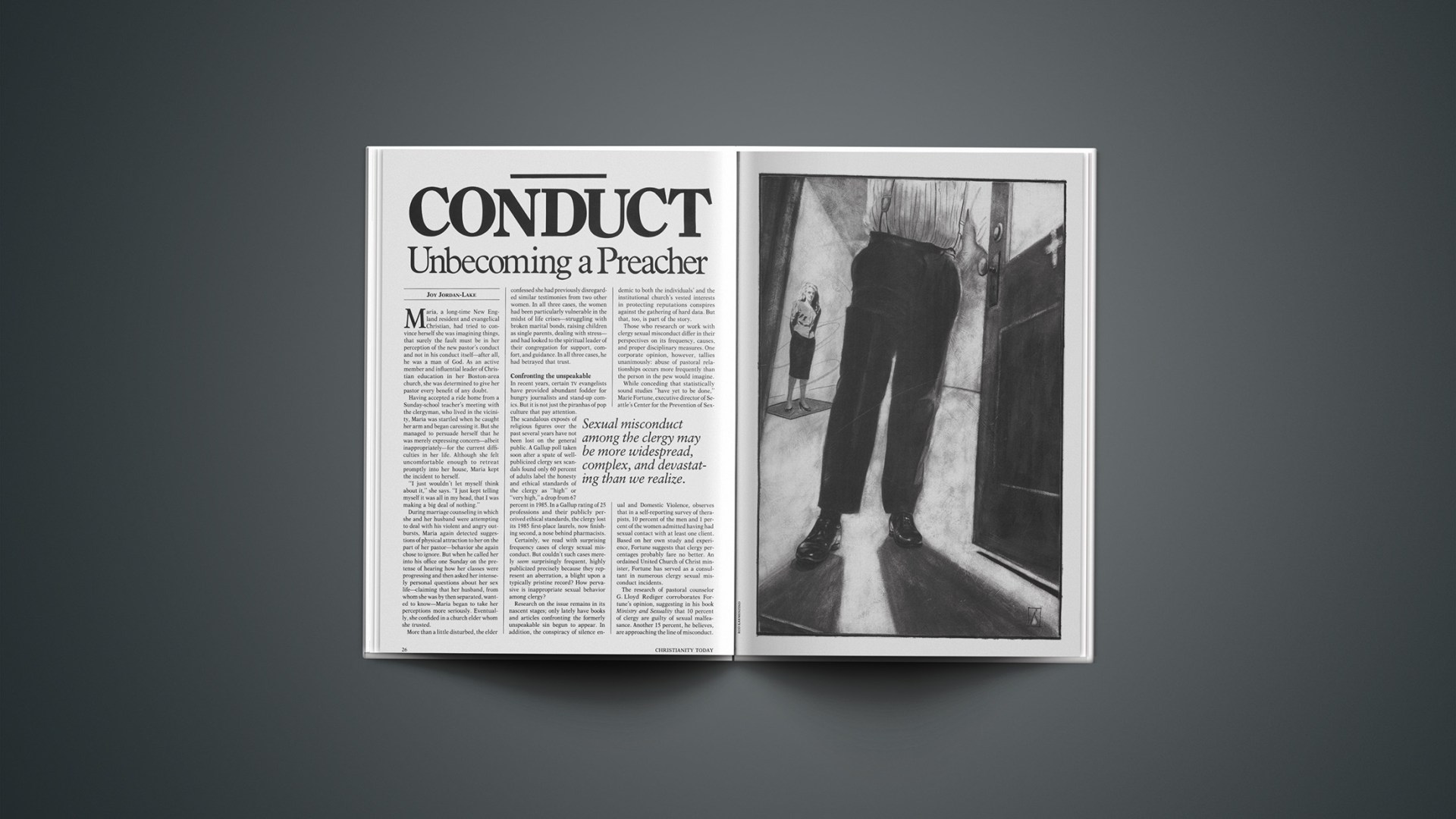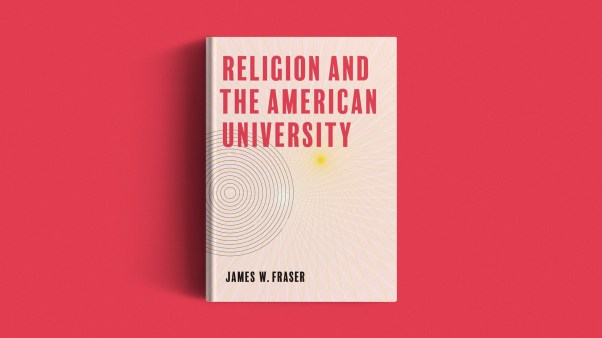Sexual misconduct among the clergy may be more widespread, complex, and devastating than we realize.
Maria, a long-time New England resident and evangelical Christian, had tried to convince herself she was imagining things, that surely the fault must be in her perception of the new pastor’s conduct and not in his conduct itself—after all, he was a man of God. As an active member and influential leader of Christian education in her Boston-area church, she was determined to give her pastor every benefit of any doubt.
Having accepted a ride home from a Sunday-school teacher’s meeting with the clergyman, who lived in the vicinity, Maria was startled when he caught her arm and began caressing it. But she managed to persuade herself that he was merely expressing concern—albeit inappropriately—for the current difficulties in her life. Although she felt uncomfortable enough to retreat promptly into her house, Maria kept the incident to herself.
“I just wouldn’t let myself think about it,” she says. “I just kept telling myself it was all in my head, that I was making a big deal of nothing.”
During marriage counseling in which she and her husband were attempting to deal with his violent and angry outbursts, Maria again detected suggestions of physical attraction to her on the part of her pastor—behavior she again chose to ignore. But when he called her into his office one Sunday on the pretense of hearing how her classes were progressing and then asked her intensely personal questions about her sex life—claiming that her husband, from whom she was by then separated, wanted to know—Maria began to take her perceptions more seriously. Eventually, she confided in a church elder whom she trusted.
More than a little disturbed, the eldercon fessed she had previously disregarded similar testimonies from two other women. In all three cases, the women had been particularly vulnerable in the midst of life crises—struggling with broken marital bonds, raising children as single parents, dealing with stress—and had looked to the spiritual leader of their congregation for support, comfort, and guidance. In all three cases, he had betrayed that trust.
Confronting The Unspeakable
In recent years, certain TV evangelists have provided abundant fodder for hungry journalists and stand-up comics. But it is not just the piranhas of pop culture that pay attention. The scandalous exposés of religious figures over the past several years have not been lost on the general public. A Gallup poll taken soon after a spate of well-publicized clergy sex scandals found only 60 percent of adults label the honesty and ethical standards of the clergy as “high” or “very high,” a drop from 67 percent in 1985. In a Gallup rating of 25 professions and their publicly perceived ethical standards, the clergy lost its 1985 first-place laurels, now finishing second, a nose behind pharmacists.
Certainly, we read with surprising frequency cases of clergy sexual misconduct. But couldn’t such cases merely seem surprisingly frequent, highly publicized precisely because they represent an aberration, a blight upon a typically pristine record? How pervasive is inappropriate sexual behavior among clergy?
Research on the issue remains in its nascent stages; only lately have books and articles confronting the formerly unspeakable sin begun to appear. In addition, the conspiracy of silence endemic to both the individuals’ and the institutional church’s vested interests in protecting reputations conspires against the gathering of hard data. But that, too, is part of the story.
Those who research or work with clergy sexual misconduct differ in their perspectives on its frequency, causes, and proper disciplinary measures. One corporate opinion, however, tallies unanimously: abuse of pastoral relationships occurs more frequently than the person in the pew would imagine.
While conceding that statistically sound studies “have yet to be done,” Marie Fortune, executive director of Seattle’s Center for the Prevention of Sexual and Domestic Violence, observes that in a self-reporting survey of therapists, 10 percent of the men and 1 percent of the women admitted having had sexual contact with at least one client. Based on her own study and experience, Fortune suggests that clergy percentages probably fare no better. An ordained United Church of Christ minister, Fortune has served as a consultant in numerous clergy sexual misconduct incidents.
The research of pastoral counselor G. Lloyd Rediger corroborates Fortune’s opinion, suggesting in his book Ministry and Sexuality that 10 percent of clergy are guilty of sexual malfeasance. Another 15 percent, he believes, are approaching the line of misconduct.
In 1987 CHRISTIANITY TODAY’s research department surveyed evangelical ministers about pastoral sexual misconduct. The results, published in the Winter 1988 issue of LEADERSHIP Journal, show that conservative churches are not immune from the problem. When asked, “Since you’ve been in local-church ministry, have you ever done anything with someone (not your spouse) that you feel was sexually inappropriate?” 23 percent said yes. In response to another question, 12 percent (approximately 1 in 8) admitted to having sexual intercourse with someone other than their spouse.
A 1990 United Methodist study on clergy and laity, Sexual Harassment in the United Methodist Church, indicated that of the nearly 1,600 individuals surveyed, nearly 23 percent of laywomen said they had been harassed, 17 percent by their own pastor and 9 percent by another minister. While the United Methodist study’s definition of harassment—“any sexually related behavior that is unwelcome, offensive or which fails to respect the rights of others”—is less specific than is desirable, its results elucidate very real, if still shrouded, concerns.
Pastors Who Love Too Much
Research has shown that a large percentage of people who enter the ministry are of a particular personality type: warm, empathic, attuned to feelings, concerned about relationships.
That makes them good pastors. But every silver lining has its cloud: this one brings with it the potential for emotional overinvolvement with a parishioner. The very trait that makes a pastor a good listener can bring him to grief, for the line between appropriate empathy and physical intimacy can be a thin one indeed.
A pastor’s personal warmth may mean he will not be comfortable maintaining a sense of professional distance. Pastors may envision themselves as a parishioner’s friend, helper, and sympathetic ear privy to the most personal feelings and intimate thoughts. But when they lose detachment and distance, ministers step into territory where judgment blurs and rationalization can run wild, where almost anything will be done for the sake of a person they care about.
To protect a pastor’s reputation and a counselee’s trust, some guidelines are in order. Try these:
Learn the signs of overinvolvement. Myth: Ministers are called to risk their all for just one of the Lord’s sheep. Fact: When the needs of a particular parishioner begin to dominate a pastor’s consciousness, he is becoming obsessive and is in danger of doing something stupid. It is probably time for that painful duty of breaking off the relationship and helping the parishioner find another counselor.
Learn to refer. Myth: A pastor is competent to counsel his parishioners. Fact: Most pastors are armed with only a meager knowledge of behavioral therapies. A pastor’s calling is, primarily, a spiritual one, helping people to find strength in God’s presence and a sense of divine direction in the midst of difficulty. Psychological adjustment is a different matter, and when it requires serious attention, pastors should find ways of partnering with professional counselors or psychiatrists.
Learn to say no. Myth: A pastor is a present help in time of emotional trouble. Fact: A pastor is not always on call for every parishioner, but has to build boundaries around family and private life like anyone else. If the request cannot be handled during reasonably structured office hours (which today must include some evening and weekend time), it is probably robbing attention from a pastor’s spouse and children or from his duty to the whole church to be a person of prayer and study.
Leave the office door ajar. Myth: Parishioners will not openly discuss what is bothering them with the possibility that a secretary might overhear. Fact: Counselees will open up soon enough. In the meantime, the knowledge that someone else is close by keeps both parties on their best behavior.
Avoid the appearance of impropriety. Myth: In these sophisticated times, no one will care if you give her a ride home after Bible study. Fact: Fat chance. Offer to pay for a taxi. And try carrying out home visitation in pairs. The Lord sent out his disciples two-by-two. No one has improved on that pattern since.
Try to arrange same-sex counseling where sexual matters are concerned. Myth: A pastor can objectively listen to and discuss a parishioner’s sexual dysfunction. Fact: A man cannot discuss with a woman the details of sexual function without mentally inserting himself into the picture. If her husband is cold, demanding, and insensitive, what man will not think himself a lot better? What would definitely be better is woman-to-woman counseling.
Enter into an accountability covenant with another minister or a professional counselor. Myth: A pastor does not need a pastor. Fact: A pastor needs to talk through professional and personal challenges with a competent professional. It is better to share your personal feelings of need with a therapist or spiritual director than with a vulnerable, trusting counselee.
Don’t feel invulnerable. Myth: It can’t happen to me. Fact: It can. As Paul told the Corinthians, “Let any one who thinks that he stands take heed lest he fall” (1 Cor. 10:12).
By the editors.
A Generic Male Malady?
Fortune adamantly differentiates between clergy sexual immorality occurring outside congregational boundaries and sexual involvement that abuses the role and invested authority of a pastor or Christian counselor. By way of analogy, she notes that while Jimmy Swaggart’s visiting a prostitute evinced “a problem with his own sexuality” and created a dilemma for his church, he “evidently did not betray his pastoral relationship” with any individual congregation members. By contrast, though, “Jim Bakker used his position and power to coerce and manipulate” a woman within his own ministry into sexual involvement. “There’s an ethical distinction here most people don’t make,” she asserts. In the CHRISTIANITY TODAY survey, over two-thirds of the cases of pastoral sexual misconduct occurred with someone within the pastor’s own congregation.
San Francisco psychiatrist Peter Rutter, author of Sex in the Forbidden Zone, concurs with Fortune and Rediger on the extent of clergy sexual misconduct and the unique ramifications of professional breach of faith. Examining over 1,000 case studies covering several professions that necessitate the development of “special trust” relationships (i.e., psychiatrists, professors, medical doctors, attorneys, and clergy), Rutter concludes that the results bode no better for religious professionals than for any others, adding, “I found this to be a generic male malady in our culture.”
But C. Roy Woodruff, executive director of the American Association of Pastoral Counselors, and Wade Rowatt, associate dean of Southern Baptist Theological Seminary’s School of Theology, argue that among ministers, there are fewer cases of sexual misconduct than in corresponding secular communities. Rowatt contends that other professions lack “the moral restrictions” of the ministry and that sexual misconduct professionally remains “not as devastating” to secular careers. Both Rowatt and Woodruff, though, perceive the crisis as occurring unequivocally “too often” and apparently with increased incidence—or at least increased reporting.
The problem seems to have manifested no preponderance in any one denomination, according to Fortune, nor have the statistics comparing mainline, evangelical, and fundamentalist churches shown notable differences in how often the problem occurs.
And though the Roman Catholic church has received significantly more media attention in regard to priests’ illicit sexual conduct, particularly pedophilia, many experts surmise the betrayal of pastoral relationships occurs with a similar frequency in Catholic and Protestant circles.
Both Fortune and Norris Smith, a consultant with the (Southern) Baptist Sunday School Board, point to a lack of accountability and clear professional guidelines among individual pastors as contributors to ethical misdeeds. Smith, a specialist in the area of forced termination of Southern Baptist pastors, conducted a study revealing “immorality” as a leading cause of their dismissals, second only to “lack or abuse of communication.” The survey defined immorality as encompassing “sexual misconduct, substantive lying and the misuse or embezzlement of church funds.”
Similarly, a 1984 report by the ecumenical Washington (state) Association of Churches concluded not only that “sexual abuse on the part of pastor and pastoral counselors … is more widespread than commonly believed,” but also that churches lacked the knowledge and organizational structures to deal with these crises. Responding to the report in his book Pastoral Ethics, Yale Divinity School professor Gaylord B. Noyce observes, “The surprise … is that the issues must be spelled out at all, since one might have thought that such knowledge and commitments could be assumed.”
In Over Their Heads
George Ensworth, clinical director of Charis Psychological Services and professor emeritus in pastoral counseling at Gordon-Conwell Theological Seminary, observes that “pastors, particularly young, highly motivated pastors, who get into trouble [are usually driven by] another issue: need for recognition, affirmation, security. The sexual aspect is secondary,” thus allowing it to “sneak up on them.”
Acknowledging “it’s less a theology issue than a personality issue,” Rowatt proposes that the current increase of stress on ministers exacerbates the problem. Under the “corporate model of the church,” he explains, “ministers are expected to be corporate heads, performing successfully in evangelism, church growth, pastoral care, social involvement in the community.… They’re being asked to do jobs they’re not trained for,” such as too much “in-depth counseling—they get in over their heads.”
Whatever the circumstances of a publicly known clergy ethics violation, the congregation is also a victim of the offense.
Inability to compete with glitzy media personalities with whom the congregation compares their pastor may create “such stress” on clergy that they neglect their own families; the minister “doesn’t see his or her family deteriorating until it’s too late,” Rowatt submits. “As stress increases, one’s good judgment decreases,” Woodruff echoes.
Rutter sees a broader cultural phenomenon of “power imbalance between men and women” contributing to the peril that women, who “in our society are taught to accept exploitation,” would not “even realize when their sexual boundaries are being encroached upon.” Not until the midseventies, he notes, did women begin to speak out on sexual harassment. To challenge one’s actual or perceived superior—professionally, academically, spiritually—has historically been dangerous for women, who may now find it unavoidable. And the corollary is clear: men must learn to shun the seductive “intoxication of power and intimacy.”
Not Just An Affair
But whatever the societal backdrop, Fortune is emphatic that this violation of the pastoral role and misuse of authority should never be considered “just an affair” or “just a momentary lapse of judgment.” She asserts that those most susceptible to the inherent attraction of a pastor, who seems to encompass compassion, sensitivity, and power, are often already experiencing a life crisis: family death, divorce, illness, physical abuse, incest. When that person is seeking help, a pastor’s abusing that trust relationship by stepping—or even allowing him or herself to be coaxed—beyond professional ethical boundaries “involves taking advantage of vulnerability.”
Dispelling misconceptions of “consenting adults,” Fortune insists that the onus of responsibility always lies with the pastor in keeping pastoral relationships within moral bounds. The dynamics of a pastor-parishioner or counselor-client relationship create a context such that any behavior moving beyond those bounds “takes place in the absence of meaningful consent”—that is, without mutuality, equality, shared power, and a nonpunitive outcome, says Fortune.
Rutter, too, maintains that “the factors of power, trust, and dependency” render the professional consistently responsible for “the seen or unseen dependency elements that ultimately develop” despite any “level of provocation or apparent consent” on the part of the parishioner. Woodruff likens the dynamics of clergy sexual misconduct, particularly in counseling, to those of an incestuous relationship, both containing “the ingredients of authority, care and nurture,” which, if abused, are “ultimately devastating.”
In some cases, however, Fortune would attest that a pastor not only knew better, but consciously capitalized on that position. In her book Is Nothing Sacred? Fortune records her work as a consultant and advocate for six women who had been sexually involved, unbeknownst to each other, with their charismatic, successful, young pastor. One, an older woman, had gone to him seeking counseling upon the death of her husband of many years. Another, quite young, sought comfort and guidance from the shepherd of the local flock—and was raped by him. All were verbally and emotionally harassed. Subsequent investigation suggested the involvement of many more women who chose to remain silent.
Of these more rare “prima donna types” Woodruff observes, “They lose a sense of their own boundaries, develop a messianic sense of themselves. They convince a woman ‘it’s okay, because I’m a man of God.’ ” Ethically and morally, he adds, they cease to “differentiate between themselves and God.”
An Ounce Of Prevention
Whatever the circumstances of a publicly known clergy ethics violation, “the congregation is also a victim of the offense,” the Washington Association of Churches’ report asserts, recommending the aid of “a trained resource person who can assist … in the healing process so that the congregation can work through the pain of this trauma and begin to carry on its mission.”
Fortune, however, reports the institutional church’s propensity to “protect itself by preventing disclosure of professional misconduct,” often at the expense of other victims. Initially concerned with maintaining its own image of integrity, she writes that the church may prefer “to shoot the messenger, that is, to denigrate whoever had the courage to tell the secret.” Often reacting too much “like a family upon the revelation of incest,” a congregation may initially attempt denial or cover-up, resulting ultimately in undermining its credibility and exacerbating harm to those involved.
The widely publicized involvement of renowned preacher and pastor of Plymouth Church in Brooklyn Heights, New York, Henry Ward Beecher (1813–87) with Elizabeth Tilton, Beecher’s parishioner and wife of his close friend, provides a classic example of this phenomenon. It began in 1868 with pastoral calls consoling Tilton on the death of her child. Four years later, rumors were flying, and by 1875, Elizabeth’s husband, Theodore, had brought litigation against Beecher. In the face of overwhelming evidence, the congregation completely exonerated their pastor. In 1878, all those testifying against Beecher were excommunicated, including Elizabeth Tilton, who died 19 years later, alienated, ostracized, alone.
Sometimes ecclesiastical mishandling of such cases may entail significant financial expenditures. Over the next ten years, for instance, the Roman Catholic church will pay approximately one billion dollars in civil lawsuits for “alleged sexual misconduct on the part of its clergy,” Fortune notes. “A lawsuit is the last resort for most people,” she believes, unnecessary “if church bodies would deal with it and provide … justice, clear acknowledgment of what happened and disciplinary action toward the offender.” If nothing else, she adds wryly, it makes “good economic sense.”
Churches on both ends of the theological spectrum handle such a tragedy ineptly, says Fortune. In her experience, conservative congregations demonstrate a proclivity for “rallying to support ‘the poor brother who’s fallen from grace,’ ” accompanied by “no attention whatsoever to the victims.”
On the more liberal end, churches that may espouse a “more open attitude toward sexuality” manifest a “tendency for not wanting to deal with it at all.” Experts agree that disciplinary action and the offender’s prospect for rehabilitation vary widely according to the nature and circumstances of the offense.
But the most efficacious approach is clearly to work at prevention. Churches should encourage mutually supportive clergy marriages; develop clear professional ethical guidelines spelling out the procedures and consequences for sexual misconduct; set limits on time, place, and circumstances of pastoral visits and counseling sessions; decrease pastoral stress factors (i.e., limit time and job demands for the pastor); and put into place ministérial accountability (to the congregation, to denominational officials, and, primarily, to God).
“Our theology,” concludes Fortune, “is more than adequate to guide our response.”










